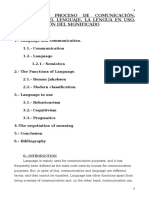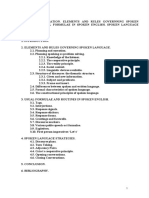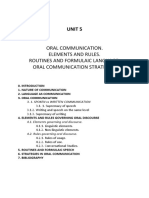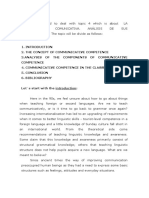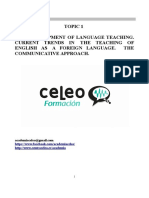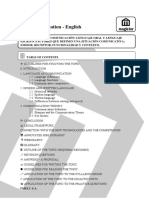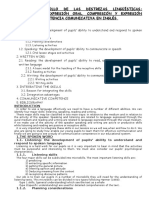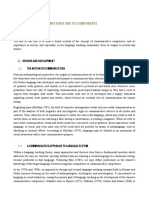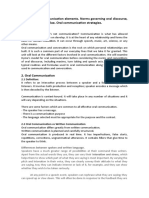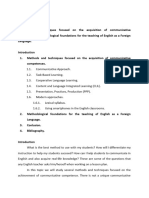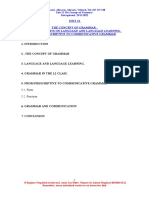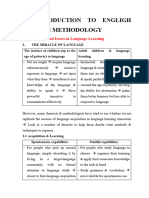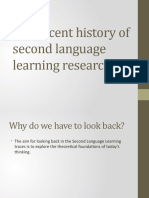0 ratings0% found this document useful (0 votes)
104 views13 pagesR2 App Harmer Chapter
Uploaded by
Umutcan GülenerCopyright
© © All Rights Reserved
We take content rights seriously. If you suspect this is your content, claim it here.
Available Formats
Download as PDF or read online on Scribd
0 ratings0% found this document useful (0 votes)
104 views13 pagesR2 App Harmer Chapter
Uploaded by
Umutcan GülenerCopyright
© © All Rights Reserved
We take content rights seriously. If you suspect this is your content, claim it here.
Available Formats
Download as PDF or read online on Scribd
You are on page 1/ 13
Background issues
in language learning
A The miracle of language
Unless there is something wrong with them mentally or physically, all children acquire a
language as they develop. Indeed, many children around the world acquire more than one
language and by the age of six or seven are speaking as confident bi- or trilinguals. This
miraculous language ‘instinct’ (Pinker 1994) seems, at first glance, to happen effortlessly.
‘The question that language teachers want answered, therefore, is whether second language
acquisition — that is language learnt in the classroom ~ can hope to replicate the conditions in
which children acquire their first language(s).
‘As far as we can see, children are not taught language, nor do they set out to learn it
consciously, Rather they acquire it subconsciously as a result of the massive exposure to it
which they get from the adults and other children around them. Their instinct ~ the mental
capability we are all born with - acts upon the language they hear and transforms it into a
knowledge of the language and an ability to speak it. It’s that simple.
Or rather it isn’t quite that simple. For example, if we consider the language exposure that
children receive, we find that it is a special kind of language. People don't speak to two and
three year olds the way they speak to adults. Instead, they (parents especially) use exaggerated
intonation with higher pitch than is customary. This conveys special interest and empathy. They
simplify what they say, too, using shorter sentences and fewer subordinate clauses. They choose
special vocabulary which the children can understand, rather than more sophisticated lexical
items which they would not. They tend to include the children in the conversation, drawing,
them into interactions so that the actual language used is an integral part of the interaction
itself. And even before children can themselves speak, parents act as if they were taking part in
the conversation, as when a mother says, for example, Do you want some more milk? (the baby
gurgles) You do? Yes, you do. All right, then... So, in a sense, children are being taught rules of
discourse even though neither they nor their parents are conscious of this. Parents ~ and other
adults — do not choose the simplified language or exaggerated intonation consciously, either. It
is usually done subconsciously, so if you asked most people exactly how they speak to children,
they would not be able to say on what basis they choose words and grammar.
Finally, children havea powerful incentive to communicate effectively. Even at the pre-word
phase of their development they have an instinct to let people know when they are happy,
miserable, hungry or alarmed. The more language they can understand — and especially speak
~ the better they can function.
All of this is bound up with the age of the child and what happens to us as our brains
develop and grow. Language acquisition is‘... guaranteed for children up to the age of six, is
steadily compromised from then until shortly after puberty, and is rare thereafter’ (Pinker
9
Al
a —
1994: 293). In other words, that instinctual ability to absorb language and context and to
transform them into an ability to understand and speak'perfectly’ doesn’t usually last for ever.
However at around the time of puberty, children start to develop an ability for abstraction,
which makes them better learners (see below), but may also make them less able to respond
to language on a purely instinctive level,
Despite the fact, then, that there is something special and unique about first language(s)
acquisition, a concern of many theorists and methodologists has been to try to see how, if at
all, we can replicate the success of that kind of language acquisition in the language-learning
classroom. We will look at # number of theories (both historical and current) that have
been advanced and which methodologists have used to help them decide what methods and
techniques to espouse.
Acquisition and learning
Some people ‘pick up’ second languages without going to lessons (though true mastery is
unusual via this route), Others go to Tanguage classes and study the language they wish to
learn, Of the two situations, picking up a language (simply absorbing it by, for example, living
in a target language community with no formal attention to language study) is, it would
appear closer to fist-anguage acquisition than studying a language in a classroom is. This
ak recognised as long ago as 1921 by the man who can be credited ‘more than any other single
individual’ with helping English language teaching to become a ‘professionhood’ (Howat
2004: 264). In his book The Principles of Language Study, Harold Palmer was interested in the
difference between‘spontaneous’ and studial capabilities, The former described the ability to
‘acquire language naturally and subconsciously, whereas the latter allowed students to organise
their learning and apply their conscious Knowledge tothe tak in hand, Palmer suggested that
ght into play for the acquisition of the spoken language,
concern. In the early 1980s the
called the Input hyporhess (cummarnedy Ne aad att
we acquire subconsciously (
spontaneous conversation
learnt, on the other hand, where’
studied a A
1enot salable fr spomtancous use in ths way, Indeed, it stat theory asf er
language isto help us to monitor (check)
‘We monitor what we are saying,
ext level up), and the students had to be
(rather as parent-child language
contrast to the finely-tuned input
h ge has been chosen for conscious
t aids acquisition, Krashen i
Srp argued, whereas finely-tuned input
of much language instruction,
learning. Roughly-tuned inpu
combined with conscious lea
———— backeroun 15sUES 1N LANGUAGE LEARNING
If Stephen Krashen were right, the implications would be profound, It would mean that
the most useful thing we could do with students would be to expose them to large amounts
of comprehensible input in a relaxed setting. Perhaps we might have students learn language
consciously at some later stage for the sake of their writing, for example, but otherwise, if we
wanted students to be effective at spontaneous communication, comprehensible input would
be enough.
The contributions of behaviourism
Anyone who has ever studied a language knows that lessons based exclusively on theacquisition
view of language described above are extremely rare, From the advent of the Direct method,
there has generally been more learning (in Krashen’s sense) than acquisition,
‘The Direct method emerged at the end of the nineteenth century and it laid the foundations
for classroom practices which are still around today (thanks to people like Maximilian Berlitz and,
later, Harold Palmer, whom we have already mentioned). The Direct method teacher used only
English in the classroom; form and meaning associations were made using real objects, pictures
or demonstration. The point here is that a concentration on form (rather than subconscious
acquisition) was considered to be advantageous. This is the very antithesis of a purely acquisition-
based view of second-language learning. Crucially, it depends on the idea that the input students
receive (that is the language they are exposed to) will be the same as their intake (that is the
language they actually absorb). Yet, as we shall see below, this is shown again and again not to
be the case. Students take in only some of what they are exposed to. And sometimes they take in
things which are incidental to the main focus of the language input they receive.
However, the Direct method, which believed essentially in a one-to-one correspondence
between input and output, really got going when it was married to the theory of behaviourism.
In an article published in the early part of the twentieth century, two psychologists, Watson
and Raynor, reported the results of an experiment they had carried out with a young boy
called Albert (Watson and Raynor 1920). When he was nine months old, they discovered that
the easiest way to frighten him was to make a loud noise by striking a steel bar with a hammer.
‘At various intervals over the next three months they frightened Albert in this way while he
was in the presence of various animals (a rat, a rabbit and a dog). The result was that after
three months Albert showed fear when confronted with these animals even when the noise
was not made, and even showed unease when a fur coat was put in front of him. Pleased
with their progress, the scientists then proposed to continue their experiment by turning the
young baby’s fear back to pleasure, but they were unable to do so because, unsurprisingly,
‘Albert was withdrawn from the experiment by his parents.
Despite its age, Watson and Raynor's experiment is of more than academic interest because
the conditioning it demonstrated ~ and the way that such research into conditioning led on
to the theory of behaviourism — had a profound effect upon teaching of all kinds. This is
especially true of language teaching where, arguably, behaviourism still exerts a powerful
influence (Bruton 1998).
In behaviourist theory, conditioning is the result of a three-stage procedure: stimulus,
response and reinforcement. For example, in a classic experiment, when a light goes on (the
stimulus) a rat goes up to a bar and presses it (response) and is rewarded by the dropping of a
tasty food pellet at its feet (the reinforcement). If this procedure is repeated often enough, the
31
cuiaereR 3 a
arrival of the food pellet as a reward reinforces the rat's actions to such an extent that it will
always press the bar when the light comes on: ithas learnt a new behaviour. ,
Ina book called Verbal Behaviour, the psychologist Bernard Skinner suggested that muc!
the same process happens in language learning, especially first language learning (Skinner
1957)."The baby needs food (the incentive we discussed above), so it cries and food is produced.
Later the infant swaps crying for one- or two-word utterances to produce the same effect,
and because words are more precise than cries, it gradually learns to refine the words to get
exactly what is wanted. In this behaviourist view of learning a similar stimulus-response-
reinforcement pattern occurs with humans as with rats or any other animal that can be
conditioned in the same kind of way.
In language learning, a behaviourist slant is evident when students are asked to repeat
sentences correctly and are rewarded for such correctness by teacher praise or some other
benefit. The more often this occurs, the more the learner is conditioned to produce the
language successfully on all future occasions. As we shall see on page 64, behaviourism was
directly responsible for audiolingualism, with its heavy emphasis on drilling (following the
stimulus-response-reinforcement model). As such, the influence of behaviourism was ~ and
is the direct opposite of any theory of subconscious acquisition,
Behaviourism is sometimes derided and its contribution to language teaching practice heavily
criticised. Yet, as Peter Castagnero suggests, the link between the audiolingual method and a
simplistic view of behaviourism is fictitious. Behaviour analysis is alive and well; he writes, and
is‘making significant contributions in applied language settings’ (Castagnero 2006: 519).
‘Language learning will take care of itself”
In his book Deschooling Society, the educational theorist Ivan Illich questioned the whole
Purpose of formal education. As the title of his book indicates, he had a very bleak view of
what happens in classrooms. We may think, he suggested, that the more input we are exposed
to, the more we learn. We may even go so far as to assume that we can measure knowledge
with tests and grades, But allthis isa delusion.
In fact, learning is the human activity which least needs manipulation by others.
Most learning is not the result of instruction. It is rather the result of unhampered
participation in a meaningful setting. (lich 1972: 56)
gues (who had the task of improving the
were soon to study on postgraduate courses
uestion the ways they had been teaching. For
grammar; they had explained vocabulary and taught
ie = to be working and it did not ‘feel right’, How would
i they abandoned all that and instead devoted their efforts to i
y exposing
en English and getting them to use it, particularly given that they were highly motivated
to learn. The hypothesis they were working on was, in Allwright’s words, that
a Ete language teachers management activities are directed exclusively at
involving the learners in solving communication problems inthe target language,
fen language learning will take care of itself... (Aliwrght gy: 170)
At about the same time, Dick Allwright and his collea
English language skills of students from overseas who
at the University of Essex in England) started to
example, they had asked students to study
paragraph organisation, But it didn’t see
it be, they wondered,
;ROUND ISSUES IN LANGUAGE LEARNING
In the course which followed, students were given tasks to do outside the classroom (such
as interviewing people and searching for library books), which involved them in speaking
and reading: real tasks for which the teachers gave no language training, advice or, crucially,
correction. Students also took part in communication games (see page 349) where the only
objective was to complete the task using all and/or any language at their disposal. A student
had to draw the same picture as their partner without looking at the partner’s picture, for
example, or they had to arrange objects in the same order as their partner without looking
at their partner’s objects ~ both tasks relying on verbal communication alone. The results,
although not scientifically assessed, were apparently favourable, Everyone enjoyed the process
far more (especially the teachers) and the students’ progress appears to have been more
impressive than in previous years.
Allwright and his colleagues had shifted the attention away from the product of learning
(knowledge of grammar and lexis) to the learning process itself. In other words, he seemed
to be suggesting, we learn to do something by doing it, and if the goal of language is
communication, then communicating as we learn is the best way to go about it. Merrill Swain
called this ‘comprehensible output’ in a clear echo of Krashen’s comprehensible input (Swain
1985). Jane Willis says ‘you must learn the language freely to learn to speak it, even if you
make a lot of errors’ (1996: 7). While not going as far as Allwright in suggesting that language
learning might take care of itself, she suggests that students need chances to say what they
think or feel and to experiment with using language they have heard or seen in a supportive
atmosphere, without feeling threatened.
Focus on form or focus on forms?
The idea that students should be involved in ‘solving communication problems in the target
language’ ~ that is, performing communicative tasks in which they have to (mostly) speak
their way out of trouble — has given rise to Task-based language teaching, which we will
discuss in more detail in Chapter 4. Task-based learning has at its core the idea that students
learn better when engaged in meaning-based tasks than if they are concentrating on language
forms just for their own sake. This is not to suggest, as Allwright speculated, that language
learning ‘will take care of itself but that learning should grow out of the performance of
communicative tasks rather than putting the learning (of previously selected language forms)
first and following it by having students perform communicative tasks.
In this context a distinction has been made between a focus on form and a focus on forms.
Focus on form occurs when students direct their conscious attention to some feature of the
language, such as a verb tense or the organisation of paragraphs. It can happen at any stage of
a learning sequence as the result of intervention by the teacher, or because students themselves
notice a language feature. It will occur naturally when students try to complete communicative
tasks (and worry about how to do it - or how they did it) in Task-based learning, for example,
or it might happen because the teacher gives feedback on a task the students have just been
involved in. Focus on form is often incidental and opportunistic, growing out of tasks which
students are involved in, rather than being pre-determined by a book or a syllabus.
Many language syllabuses and coursebooks are structured around a series of language
forms, however. Teachers and students focus on them one by one because they are on the
syllabus. This is often called ‘focus on forms’ because one of the chief organising principles
behind a course is the learning of these forms.
33
a __—
CHAPTER 3
Somecommentatorshave argued passionately that focuson form —which grows incidentally
out of communicative tasks ~is significantly more effective than focusing on langues a
just because they are there, Indeed Michael Long erred tothe latter practices as meander
{a988: 136). As Ron Sheen (oho is largely unimpressed by the argument that focus on form
in general is mote effective than focus on forms) explains it,'an underlying assumption &
focus on form approach is that all classroom activities need to be based on communicative
tasks, and that any treatment of grammar should arise from difficulties in communicatingany
desited meaning (Sheen 2003 225), According to Sandra Fotos, ‘Research ... suggests that task
performance can significantly imcrease learner awareness of the target structure and improve
accuracy in its use, as well as providing opportunities for meaning focused comprehension
and production of the target language’ (Fotos 1998: 307)-
‘One way of focusing on form that has attracted a considerable amount of attention was
described by Richard Schmidt as ‘noticing. He uses the term to describe a condition which
is necessary if the language a student is exposed to is to become language ‘intake, that is
language that he or she takes in (Schmidt 1990). Unless the student notices the new language,
he or she is unlikely to process it, and therefore the chances of learning it (and being able to
use it) are slim,
‘According to Schmidt, and based to some extent on his own learning of Portuguese, second
language learners notice a language construction if they come across it often enough or if it
stands out in some way. One way of coming across it, of course, is through instruction ~ that
is, if teachers draw their attention to it, But learners are quite capable of noticing language
features for themselves (as Schmidt did) on an advertising billboard, in a TV programme of
a newspaper or, for example, in what someone in a convenience store says to them every time
they go to buy some milk. According to Tony Lynch, .. Noticing is certainly part of successful
language learning; one can hardly imagine (adult) learners making substantial progress
without it (Lynch 2001: 25).
Noticing has one other characteristic, that of salience, Things that are salient (ie. that
stand out more) are more noticeable. Forms which call attention to themselves and are
perceptually salient will have'a greater chance of impinging on consciousness’ (Skehan 1998:
49). Gerald Kelly, in his book on pronunciation, suggests that a language item needs... to be
relevant to the student ata particular time in order for there to be conscious intake and before
the student can use it consistently’ (Kelly 2000: 22). Salience, then, seems to apply to forms
which have made themselves noticeable or prominent, and which also arrive just at the right
‘moment because the learner is ready for them (they are relevant).
The argument might, then, go something like this: students acquire language best when
the i i :
ey have focused oni ther because they nee i, or have come across it in a meaning”
focused communicative task or because in some
‘other way they have noticed language which
is relevant to them at a particular time; this ki iti ae
; 5 this kind of acquisition is intrinsi erior to
asking students to focus on a series of pr for nscale
tud re-determined forms.
This, if it were true, would make the labus orp
difficult.
job of the syllabus or program designer extraordinarily
Making sense of it all
We
e Eo ae nak sense ofthe theories and hunches which have been offered t0
"since they compete on a variety of different levels. For example, if we were t©
BACKGROUND ISSUES IN LANGUAGE LEARNING
accept that noticing was a pre-condition for acquisition, then the claim that students acquire
language best by subconscious exposure to comprehensible input would be untenable. If we
were attracted by the notion of language conditioning, then letting language learning ‘take
care of itself” would make no sense. If we were convinced by arguments for a focus on form,
then focusing on discrete language forms in a syllabus would not be the right thing to do.
The problem for us as teachers is that we recognise the merits of many of these arguments.
For example, repetition clearly works, and we are powerfully affected by rewards (they will
be called ‘medals’ on page 138). Hence behaviourist influences on language teaching do not
seem completely absurd. It is also clear that we do acquire some language subconsciously, and
that, just as Krashen suggested, an exaggerated concern for accuracy when we monitor our
output can impede spontaneous speech. It is evident that trying out the language we know
wwe are learning in meaning-focused tasks actually helps us to sort things out in our heads.
Indeed, it may be that in making efforts to retrieve and then use all and any of the language,
wwe flick a ‘switch’ that takes language from the learnt to the acquired store (Ellis 1982). But at
the same time, the argument that this is the best or only way to do things is“. undermined by
the experience of the countless people who have apparently learnt languages successfully by
“traditional” methods incompatible with the hypothesis’ (Swan 2005b: 379).
When examining the various claims in detail, however, certain problems crop up. A
behaviourist view of language learning, for example, seems unable to cope with the fact that
language learners frequently come out with language that they have never seen or used before.
‘We make new sentences all the time, yet this creativity flies in the face of a belief which says
that all language is the result of conditioning.
It seems entirely plausible to suggest that noticing specific items of language helps them
to become fixed in our language store, yet the suggestion that this is in some sentences a
necessary pre-condition for acquisition is somewhat problematic. Michael Swan (echoing a
point made by Noam Chomsky about first-language acquisition many years before) wonders
how it is possible that competent non-native speakers know that we can make sentences such
as I offered/promised/guaranteed Andrew £100, but not *! donated/presented Andrew £100. As
he points out, this knowledge cannot come about ‘.. by noticing exemplars, since there are no
exemplars to notice; the non-use of a structure is not manifested through specific instances’
(200sb: 380). Nor is the concept of salience easy to sustain at all times when it is quite clear
that students seem to notice things that aren't especially salient, yet don’t seem to notice other
things which are prominent ~ or which we bring to their attention.
nally, the suggestion that acquisition and learning are such separate processes that learnt
language cannot be part of the acquired store is not verifiable unless we are able to get inside
the learners’ brains. Otherwise we fall back on asking people whether the language they used
was learnt or acquired (in other words whether it was the result of conscious or subconscious
processes), and the problem is that they usually won’t be able to tell us. We are left, then, with
a hypothesis which is untestable and which seems counter-intuitive, even though we cannot
be confident about that either.
‘What we can say with confidence, however, is that learning success is closely bound up with
both the method of teaching and, more crucially, the personality and age of the learner. We
will examine these issues in detail in Chapter , but here it is worth pointing out that adults,
in contrast to children, often depend upon their ‘considerable intellects’ (Pinker 1994: 29) to
35
—————
cuaprer 3 ———
help them understand grammar; even if we wanted our students to only acquire language
subconsciously (which they do some of the time), they would still think about what they were
learning, Some students like to analyse what they are learning more than others.
Ina wide-ranging survey article on the teaching of grammar, Rod Ellis suggests, among
other things, that students need to focus not just on grammatical forms but also on their
meanings, and that focus on forms is valid, provided that students are given chances to use
the discrete forms they have studied in communication tasks (2006: 102). But it is also clear,
he points out, that‘an incidental focus-on-form approach is of special value because it affords
an opportunity for extensive treatment of grammatical problems (in contrast to the intensive
treatment afforded by a focus-on-forms approach)”
“To sum up, therefore, students need considerable exposure to language for without it there
is no chance of any acquisition, The best kind of language for this purpose is comprehensible
input, Students also need to try to use language in meaning-focused tasks. This helps them
to try out language and think through how it works. Students also need to study language
~ or focus on it in some way or other. This may take place during or as a result of meaning-
focused tasks, but it may also happen because students notice an aspect of language and.
think about it or because we bring that language to their attention. It is possible that some
language is remembered as a result of repetitious practice ~ or at least that this practice
leads to significant noticing - and that rewards such as success or teacher approval may help
students to remember in this way.
Finally, we might agree with Guy Cook when he says that ‘What is needed... is a recognition
of the complexity of language learning: that it is sometimes play and sometimes for real,
sometimes form-focused and sometimes meaning-focused, sometimes fiction and sometimes
fact’ (1997: 231). We will discuss language play in Section F below.
The importance of repetition
Repetition has always played a part in language learning, even if its efficiency in helping
students to transfer knowledge from their short-term to theit long-term memories is not
firmly established. Nevertheless, we suppose that if students think about what they are
repeating and try to organise it in their heads, they stand a better chance of remembering
what they are learning than if they merely itwit
'y merely repeat it without thought (see Section C below).
However, one kind of repetition is of vital imy ie eeererash
: portance in language learning, and that is the
repetition of encounters with language. It is this repetition whi ps fix thi
een of encounters wh language. Is his epetton which really helps cing ia
if students see or hear some lan, i
i : guage once, they might, even when
they notice it forget it fairly quickly. But the more they come across this language — the more
repeated encounters they have with it - ven
a the better chance they have of remembering (and
Howe i
a Tecerepeatingsomethinga number of times, one after the other, isn't especially useful.
oreo Tepeated encounters with language which are spaced out ~
st anguage which sd see back to again and again, with time lapses in between.
ere ew fom repeating tasks. Thus, if they have told a story, for example,
cael stout ow ther id it, telling the story again allows them to re-use words and
» re-formulating what they said the first time ina way that helps them to think about
—— nackorounp tssvss 1 LANGUAGE LEARNING
language even as they use it. Perhaps this will provoke the structuring and re-structuring of
‘noticed’ language that is necessary if the learner is to adjust the hypotheses they have formed
(Batstone 1994: 40-43).
Thinking about language
Many students seem to learn better if they are asked to think about the language they are
coming into contact with. For example, we could get students to repeat a sentence such as If
Thadn’t overslept, I wouldn't have missed the bus and they might well understand it. But they
might forget how it was constructed unless we allowed them to think about the arrangement
of sentence elements and verb tenses. Thinking about the sentence allows students to employ
their ‘considerable intellects’ (see page 55). Of course, as we shall see in Chapter 5, different
students respond differently to such analysis (and we will be less likely to use it with younger
learners), but common sense tells us that if we look carefully at something, we see it better
than if we just glance at it.
‘We can go further and say that if students have to make decisions about the words and
grammar they are studying ~ that is if their encounter with the language has some ‘cognitive
depth’ — they are far more likely to understand and remember that language than if they meet
the new language passively. Indeed, one school of thought which is widely accepted by language
teachers is that the development of our conceptual understanding and cognitive skills (in
this case by thinking about and making decisions about language) is a main objective of all
education, even more important than the acquisition of factual information (Williams and
Burden 1997: 24), Such conceptual understanding is arrived at not through ‘blind learning; but
through a process of exploration which leads to genuine understanding (Lewis 1986: 165).
‘The practical implications of this view are quite clear: instead of explicitly teaching the
present perfect tense, for example, we could expose students to examples of it and then allow
them, under our guidance, to work out for themselves how it is used. Instead of telling students
which words collocate with crime, we can get them to look at a dictionary or a computer
concordance of the word (see page 34) and discover the collocations on their own. Instead of
telling them about spoken grammar, we can get them to look at transcripts and come to their
own conclusions about how it differs from written grammar. What we are doing, effectively,
is to provoke ‘noticing for the Jearner’ (see Batstone 1994: 72 and Aq above).
One powerful reason for encouraging language students to discover things for themselves
is the complex nature of language itself. While there may be an argument at lower levels
for reducing its complexity into manageable pieces, students who encounter real language
outside the classroom will find thatit is considerably‘ messier’ than it may appear ina language
lesson, Their response to this may well depend on how prepared they are to observe this
messy language and work out, for themselves, how it is put together. Any training in language
analysis we have given them will make them more able to do so.
Discovery learning may not be suitable for all students, however, especially if it conflicts
with their own learning expectations or culture. One student in a piece of research by Alan
Fortune which compared discovery activities with more traditionally taught grammar said, ‘I
feel more secure with a rule because my intuition does not tell me a lot’ (Fortune 1992: 168).
Nor is it clear whether such techniques work equally well with all items of grammar or le:
37
CHAPTER 3 ————
IF the language that students are exposed to is over-complex, they may find it aire
make any meaningful analysis of it on their own, even if they understand more or less what
jLameane, But in Alan Fortune's study, quoted above, experience of such activities caused a
significant numberof informants to end up preferring them to more familiar activities,
‘Getting students to think for themselves is one aspect of what is often referred to as
sjearner-centredness:, Learner-centred classrooms and lessons (where the learners are doing
most of the work, often in pairs and groups) are often seen as opposite to ‘teacher-centred
lessons, where the teacher is deciding what should happen and where he or she is the centre of
attention, For many commentators, learner-centred teaching is preferable to teacher-fronted
lessons (where the teacher is at the front, ‘teaching’ the class). However, as we shall see in
Chapter 6, teachers are called upon to play a number of different roles, and as we shall see in
Chapter 5, putting students at the heart of learning demands theit willing participation and
agreement to take agency for what they are doing,
Arousal, affect and humanistic teaching
If, when students meet new language, they arc listless and disengaged, they are far less likely
to remember what they encounter than if they are engaged and emotionally open to what is
going on. A very high degree of attention seems to correlate with improved recall (Thornbury
2o01a: 25). In the same way, the students’ feelings about a word seem to matter. Do they like
what it means? Do they like how it sounds and what it looks like? Do they have good or strong,
associations with the word? Indeed, when we introduce students to new words, can we create
a ‘cuddle factor’ (Harmer 1991), which will help them to have an emotional attachment to
{and therefore better recall of) the word or phrase?
Students’ feelings (often referred to as affect) go way beyond concerns about how people
learn and remember language items, They relate to the whole learning experience and influence
how students feel about themselves. Afterall, in the presence of overly negative feelings such as
anxiety, fear, stress, anger or depression, our optimal learning potential may be compromised’
(Arnold and Brown 1999: 2). The American writer Earl Stevick called these negative feelings
“alienations’ and suggested that to counter these states, humanist approaches are called for
(Stevick 1976). Stephen Krashen, whose ideas were discussed in Al, would probably agree. His
claim for the beneficial value of comprehensible input depends upon the students being relaxed
and feeling positive and unthreatened. If they are not, then their affective filter is raised and
blocks the input from being absorbed and processed. But if, on the other hand, the affective
filter is lowered ~ because students are relaxed ~then the comprehensible input the students are
exposed to will contribute far more effectively to their acquisition of new language.
ao ae oan ao a a feel positive about learning - that the
eee parhologis Ca Rogers, whose impact upon this line of thinking
, suggested that learners need to feel that what they are learning is
ee tothem, that they have to experience learning (rather than just being taught)
should a to be enhanced as part of the process (Rogers 1969). Education
Inahumanis classroom sedentary tas toa small language learning faci
to reflect on he ai lents are emotionally involved in the learning, they are encouraged
ow learning happens and their creativity is fostered. The teacher can achieve
$$ reno unn 1st tts LANGUAGE LEARNING
this by keeping criticism to a minimum and by encouraging them, in plain terms, to feel good
about themselves. In a humanist classroom, learning a language is as much an issue of personal
identity, self-knowledge, feelings and emotions as itis about language.
However, not everyone is happy with this humanistic view of the language learning
experience. Some humanist activities, for example, encourage students to speak from their
‘inner’ selves, saying how they feel about their lives, or, perhaps, describing their closeness
to different members of theit families. John Morgan and Mario Rinvolucri describe such
activities as allowing students to ‘exteriorise their own internal text’ (1988: 9). But critics
question whether it is the teacher's job to ask students to reveal things of a private nature, and
sometimes even to monitor and nurture the students’ inner selves. There is some criticism,
too, that there is a strong cultural bias to this view of teaching and learning which would
be inappropriate in certain situations. Furthermore, a concentration on the inner self may
limit the range of language that students can experience, with more emphasis being placed
on interpersonal and informal language at the expense of other kinds. Lastly, some doubters
suggest, paying too much attention to affective issues in learning may mean that teachers
neglect their students’ cognitive and intellectual development.
Nevertheless, it is clearly better for students to have positive rather than negative feelings
about how and what they are learning, And we know that students are far more likely to learn
and remember effectively if their attention is aroused and if they can ‘cuddle’ the lexis and
grammar that they meet.
When you're ready!
Many theorists and researchers have wondered whether a student's ability to learn new things
depends on whether or not they are ready to learn it. For example, Manfred Pienemann.
suggests that teaching can promote acquisition if what we are teachingis close to the next form
that would be acquired naturally in the learner’s interlanguage. His ‘teachability’ hypothesis
suggests that if you try to teach students language before they are ready for it, ie. if you go
directly from stage 2 to stage 4, without passing through stage 3, the student may always revert
back to stage 2, because they were not ready for stage 4 (Pienemann 1998).
‘A similar concern with readiness informed the work of Lev Vygotsky, a psychologist
working in the Soviet Union in the 1920s and 1930s. He believed that all learning, including
language learning, is mediated by social interaction. Learning is ‘assisted performance’, and
this happens when someone with more knowledge ~ say a parent or a teacher ~ helps the
learner to progress. This help is called ‘scaffolding, a kind of supportive framework for
the construction of knowledge, and the scaffolding is only removed when the learners can
appropriate the knowledge for themselves.
‘A key element of successful scaffolding is that the learners can only benefit from it if they
are in the Zone of Proximal Development (ZPD) ~ in other words, if they are just getting to
a stage (above their own current level of knowledge) where they are ready to Jearn the new
thing with the assistance of others. Interestingly, this is not dissimilar to Krashen’s idea of i +
1 (see page 50).
Patsy Lightbown and Nina Spada suggest (2006: 165) that teachability research is important
primarily for helping teachers to understand why their students don't always learn what they
59
(CHAPTER 3 ——_—
ae taught ~at east not immediately. It is, perhaps, less successful in helping us to decide what
te teach since individual students wil often be at different levels of readiness. Nevertheless
wwe will try to match the language we teach (or which the students notice or are made aware
Of to an individual or a group’ apparent level or readiness. However, even language which i
too advanced may be of use if students notice it: when they are ready for it later, there is some
familiarity about it.
Tn recent years the concept of scaffolding ~ that is helping students to progress through
interaction with someone with better knowledge, such as a teacher — has gained widespread
credence, and helped us to focus on how teachers and students interact, especially when,
for example, we reformulate what students have said (see page 145), or when we help and
prompt them to try out new language. Scaffolding is thus seen as different from introducing
new language in a more formal way. However, entering into such a dialogic relationship with
students (Thornbury 2001b) may be more problematic with a large class.
Language play
In recent years researchers and theorists have turned their attention to the area of language
humour and language play. There are many reasons for this, chief among which is the idea
that it is not just work language or the transactional language of communicative tasks which
attracts people when they are free to choose, but that of ‘songs, games, humour, aggression,
intimate relations and religion’ (Cook 2000: 159). Cook points out that language play includes
mimicry and repetition, the explicit discussion of rules and the liking for ‘form-driven rather
than meaning-driven behaviour (page 171).
A moment's reflection will remind us of the formulaic nature of many jokes and playful
rhymes. There is often repetition of structures and lines, and the use of meaning puns to create
effects. Furthermore, play (and language play) is often a collaborative affair, and according
to Asta Cekaite and Karin Aronsson (who observed children with limited L2 proficiency in
spontaneous peer conversations), ‘Playful mislabelings and puns often generated extended
repair sequences that could be seen as informal “language lessons” focused on formal aspect
of language (Cekaite and Aronsson 2005: 169). They found that student joking included
in =a te switching, Jaughter and variations in pitch among other
hie. many ingredients for successful classroom-based language
1 on view when children were playing in this way.
Play is seen as something that children do, but the case being made here is that it is highlY
appropriate in all L2 classrooms, The right kind of
affect. Much play and humour is co~ ceases ae ae ere
constructed, so students hi Py
F y i lave to work together. A lol
of ply and joke ling is rule-bound and linguistically repetitive. And at least some people
remember joke 0 Play routines, Finally, as Guy Cook has pointed out, humour and playful
Py large amounts of our real-life existence, however ‘unreal’ they are. For all of
these reasons, the formulaic i
jokes and dialogues of much ELT, i
well be extremely useful for student language development. ‘hen ropes ceseness
— sackarounp 1ssv8s iN LANGUAGE LEARNING
Chapter notes and further reading
© Acquisition and learning
Probably the best (and most approachable) overview on second language acquisition
research is P Lightbown and N Spada (2006).
For more on the contribution of Harold E Palmer, see RC Smith (1999) and A Howatt
(2004; Chapter 17).
Krashen's views are effectively challenged in K Gregg (1984). See also J Harmer (1983) and a
review of an earlier Krashen book in R Ellis (1983).
© Behaviourism
For an easily digestible view of behaviourism, the work of Skinner (for example) and its use
in audiolingualism and structuralism, see M Williams and R Burden (1997: 8-13).
‘© Noticing
On noticing activities, leading on to structuring and re-structuring, see R Batstone (1994:
Chapter 7). For a discussion about the merits of noticing, see J Harmer (2003).
© Repetition
See G Cook (1994).
Humanistic teaching
Nearly ten years apart, D Atkinson (1989) and N Gadd (1998) express doubts about
humanistic teaching and wonder how far it should be taken. However, humanism is
defended passionately in A Underhill (1989) and J Arnold (1998). For a useful collection of
articles on affect in language learning, see J Arnold (ed) (1999).
© Readiness
See also M Pienemann (1999). Vygotsky's work was not widely known for some time
ecause of his status in post-revolutionary Russia, but see Vygotsky (1978).
© Language play
See E Tarone (2000) and especially G Cook (2000). On humour in ELT, see P Medgyes
(2000).
61
You might also like
- Topic 5. La Comunicación Oral. Elementos Y Normas Que Rigen ElNo ratings yetTopic 5. La Comunicación Oral. Elementos Y Normas Que Rigen El7 pages
- Topic 2 - General Theories About Learning and Acquisition of A Foreign Language. The Concept of Interlanguage. Error AnalysisNo ratings yetTopic 2 - General Theories About Learning and Acquisition of A Foreign Language. The Concept of Interlanguage. Error Analysis5 pages
- T4 Communicative Competence Analysis of Its ComponentsNo ratings yetT4 Communicative Competence Analysis of Its Components6 pages
- Topic 9: RD 126/2014 28 February Which Establishes The Teaching Requirements For Primary Education NationwideNo ratings yetTopic 9: RD 126/2014 28 February Which Establishes The Teaching Requirements For Primary Education Nationwide9 pages
- Topic 1 The Development of Language Teaching. Current Trends in The Teaching of English As A Foreign Language. The Communicative ApproachNo ratings yetTopic 1 The Development of Language Teaching. Current Trends in The Teaching of English As A Foreign Language. The Communicative Approach21 pages
- Unidade 31 - Texto e Contexto - Tipos de Texto - Criterios para A Clasificación Textual - o RexistroNo ratings yetUnidade 31 - Texto e Contexto - Tipos de Texto - Criterios para A Clasificación Textual - o Rexistro8 pages
- Tema 01 Didactic Evolution of LanguagesNo ratings yetTema 01 Didactic Evolution of Languages13 pages
- Tema 4: The Communicative Competence and Its ComponentsNo ratings yetTema 4: The Communicative Competence and Its Components6 pages
- Evolution of Language Teaching. Present Day Trends in Tefl. Communicative ApproachesNo ratings yetEvolution of Language Teaching. Present Day Trends in Tefl. Communicative Approaches3 pages
- Cohesion in English: Constituents of Text 1. Texture 2. Ties 3. Cohesion 1. TextureNo ratings yetCohesion in English: Constituents of Text 1. Texture 2. Ties 3. Cohesion 1. Texture13 pages
- GHPĐC - LESSON 1 Background Issues in Language LearningNo ratings yetGHPĐC - LESSON 1 Background Issues in Language Learning9 pages
- Issues and Themes in Classroom ManagementNo ratings yetIssues and Themes in Classroom Management52 pages
- The Recent History of Second Language Learning ResearchNo ratings yetThe Recent History of Second Language Learning Research28 pages









